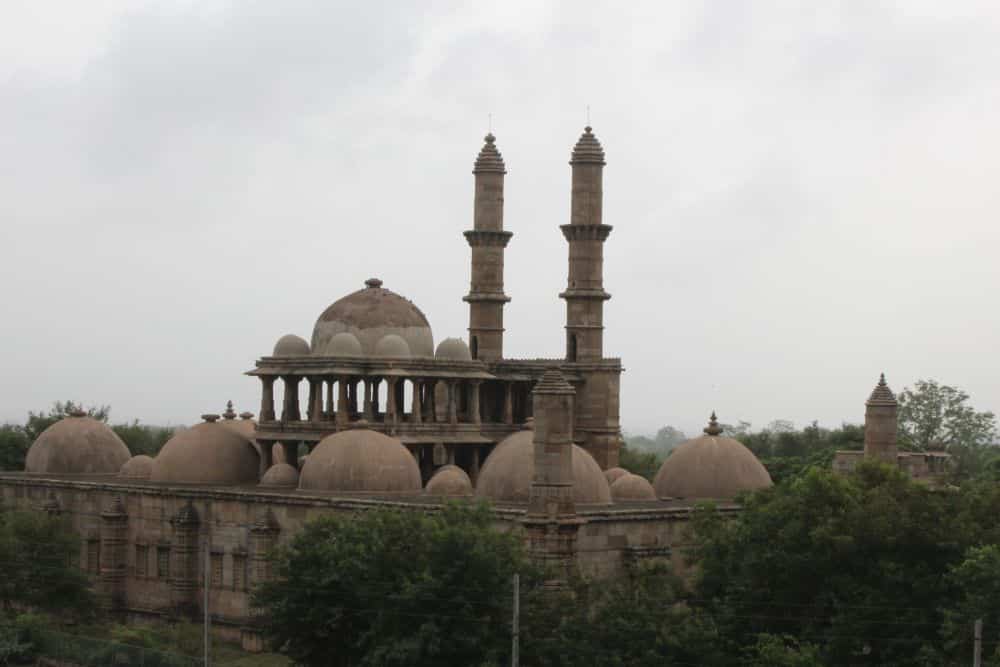Champaner-Pavagadh Archaeological Park
By Hiral Pandya
What is Champaner-Pavagadh Archaeological Park?
Located in the Panchmahal district of Gujarat, India, Champaner-Pavagadh Archeological Park is a twin site in which Champaner sits on the foothills of Pavagadh. The complete site is scattered with remains of many heritage-rich monuments such as mosques, stepwells, temples, fortresses, tombs, and arches, ranging from prehistoric sites to the 16th century, when it was the capital of Gujarat. It is, according to UNESCO, “the only complete and unchanged Islamic pre-Mughal city.”
Disclosure: This article contains affiliate links. Making a purchase through an affiliate link will mean a small commission for this website. This will not affect your price. Privacy policy.

Champaner
Built between the 8th and 16th century, Champaner houses beautiful mosques: Jami Masjid, Kevada Masjid, and Nagina Masjid, and also a citadel with sleek arches.
- Jama Masjid is huge with multiple domes, two minarets, and beautiful carvings.
- Saher ki Masjid was the former royal mosque.
- At Kevada Masjid you can climb onto the roof and up a minaret to see the view.
- Nagina Masjid has more beautiful carvings but no minarets.
- Minar ki Masjid is, unlike the others, made of bricks.

Pavagadh
The Goddess Kalika Temple (Kalika Mata) sits on the peak of Pavagadh Hill and has a surrounding citadel with seven arches called Saat Kaman.
Why is Champaner-Pavagadh Archeological Park a UNESCO World Heritage site?
The blend of Hindu and Muslim architecture of mosques, exquisitely carved minarets, the water-retention system of stepwells, and the 16th-century cultural city atmosphere make Champaner-Pavagadh Archeological Park unique. This blend “became a model for later mosque architecture in India,” according to UNESCO. It is “an outstanding example of a very short living capital, making the best use of its setting, topography, and natural features.” It also continues to be a place of pilgrimage for Hindus.

What can you expect on a visit to the Champaner-Pavagadh Archaeological Park?
The stunning architectural details like latticework of windows, courtyards with numerous pillars, intricate stone carvings, and huge domes are some of the unmissable features at Champaner-Pavagadh Archaeological Park. You can expect to go back in time with these historical monuments and can only imagine how the city must have been during the 16th century.
Apart from mosques, there are also some other structures like an old customs house which was used to collect taxes, arched gateways, cannons, and pillared hallways. Unfortunately, some of the monuments lie destroyed or damaged.
The Champaner-Pavagadh Archeological Park is adorned with well-manicured gardens which preserve that old royal feel of the heritage buildings.

Is Champaner-Pavagadh Archeological Park worth visiting?
Definitely, it is! Especially the phenomenal Jami Masjid (Great Mosque) of Champaner is worth visiting as it is the first and foremost model of the mosque which then later became an example for the rest of the mosque architecture in India.
Exploring this park only takes half a day. Hence, I absolutely recommend that you spare a few hours to take a special trip.
Use the map below to book accommodations in the vicinity of the park:
What sorts of travelers would like Champaner-Pavagadh?
There are tons of stories related to each structure, while the minute detailing of the edifices is worth appreciating. So those who are keenly interested in history, heritage, and architecture will like to visit the Champaner-Pavagadh Archaeological Park.

Tips for visiting Champaner-Pavagadh
Make sure to visit during the winter months (November-February) or during the monsoon months of July and August. As it is surrounded by a wildlife park and lots of greenery, during the rainy season, it gets more charming than it already is.
Because of the popularity of the Goddess Kali Temple on the Pavagadh Hill, weekends and festivals like Navratri are extremely crowded. Try to visit on a weekday, if possible, when it’s not a Hindu holiday.
The nearby city of Vadodara is also worth taking a trip to check out Laxmi Vilas Palace (four times the size of Buckingham Palace), and the historic city of Ahmedabad, which in itself is a UNESCO World Heritage site.
While Champaner-Pavagadh contains pre-Mughal architecture, there are several UNESCO sites that showcase outstanding examples of Mughal architecture: Agra Fort and the Taj Mahal are the best known, but Fatehpur Sikri is equally a masterpiece.
Where is Champaner-Pavagadh Archaeological Park?
To get to Champaner-Pavagadh Archaeological Park, you will have to take a car/taxi from the nearest cities of Vadodara (49 km or 30 mi) or Ahmedabad (146 km or 91 mi).
Compare rental car prices or take a private guided tour from Ahmedabad.
By car: Take the Halol Road from Vadodara.
By public transport: Vadodara and Ahmedabad are both well-connected through main train lines like Shatabdi and Rajdhani and can also be reached through their respective airports. From there, hiring a cab to the Champaner-Pavagadh Archaeological Park is the most convenient option.
Book trains, buses and/or taxis in India here.
For more information about Champaner-Pavagadh Archaeological Park, its opening hours and admission fees, see this website or the Ministry of Culture’s website.
Have you been to Champaner-Pavagadh Archaeological Park? If so, do you have any additional information or advice about this UNESCO World Heritage site? Please add your comments below!
